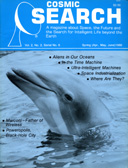![[NAAPO Logo]](../../Images/NAAPOsm.jpg) North American AstroPhysical Observatory (NAAPO)
|
|
Space Happenings
By: Editors
X-rays from the Edge of the Universe
The most distant known object in the universe, quasar OQ172, radiates not only radio and light waves but also x-rays, according to recent measurements with an x-ray telescope aboard the High Energy Astronomical Observatory (HEAD-2) now orbiting the earth.
A team led by Dr. William P. Ku of Columbia University obtained an x-ray picture of OQ172 with the satellite telescope which registered 60 photons from the quasar, a photon being the basic energy packet by which light, radio. waves, x-rays and other
electromagnetic waves are transmitted. Although this is not a large number, it is significant to find that the most distant known object in the universe emits x-rays as well as longer wavelengths with their correspondingly lower energy photons (see
"ABCs of Space," part B, page 32). This information will be helpful in improving our understanding of the nature of such distant quasars.
The quasar OQ172 was discovered in 1969 during the Ohio State University Radio Observatory sky survey at 21 centimeters wavelength. Its great distance of 14 billion light years, close to the "edge" of the universe, is inferred from its rapid velocity of recession (91 percent of the velocity of light) associated with the enormous Doppler shift of its radiation to longer wavelengths (redshift value of 3.54). See "ABCs of Space," Part C in this issue on page 35. For an explanation of the Doppler or redshift see "ABCs of Space," Fall 1979, Part A, page 25.
Quasar Outburst Observed
Quasar OV-236 has been observed in recent years by Drs. Alex G. Smith, Frank F. Donivan and others at the University of Florida, Gainesville, to undergo 10 fold brightness variations but during this time the radio strength has remained relatively constant. Now Dr. William A. Dent and Thomas J. Balonek of the University of Massachusetts, Amherst, report that during 1979 there has been a radio outburst from OV-236 at centimeter wavelengths during which its strength has increased by more than a factor of 3 making OV-236 the strongest known quasar in the sky at wavelengths of about 1 centimeter.
Quasar OV-236 was discovered in 1970 during the Ohio State University Radio Observatory sky survey at 11 and 50 centimeters
wavelengths. A Doppler shift for its emission has not been measured so its distance is uncertain.
|
